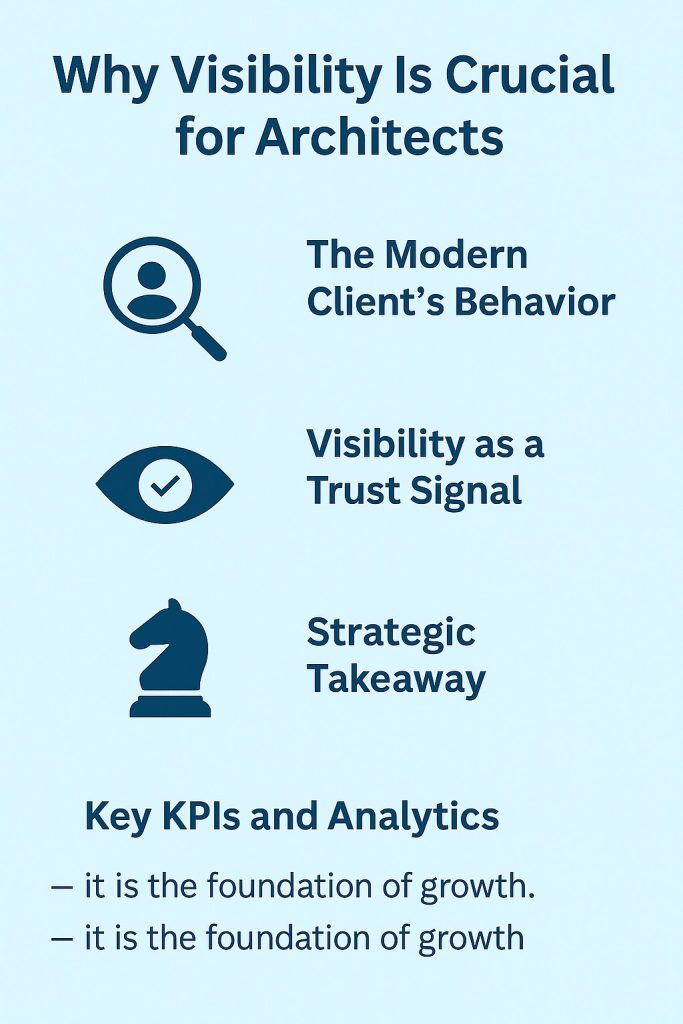The architecture industry has long relied on reputation and referrals to win projects. A decade ago, word of mouth, glossy brochures, and networking events were enough to keep firms visible. But in 2025, the client journey looks very different. Today, whether it’s a homeowner exploring options for a modern renovation, a corporate developer evaluating proposals, or a public institution shortlisting firms, the first step almost always begins online. That’s why embracing strong marketing foundations is essential—leveraging insights from digital marketing trends and adopting affordable PR strategies can help architecture firms stand out, build trust, and attract clients in an increasingly competitive landscape.
Get Model Digital Marketing for Architects
This is why digital marketing for architects has become a core business function worldwide. It is not about being creative for creativity’s sake—it is about building a measurable growth system that drives brand authority, client acquisition, and long-term visibility. By implementing well-structured digital strategies such as SEO, content marketing, social media campaigns, and paid ads, architecture firms can compete on a global stage while also targeting their local markets with precision. To explore proven techniques that elevate visibility and engagement, check out these Best Digital Marketing Strategies that can be tailored for architecture firms.

Global leaders such as Gensler, Foster + Partners, Perkins & Will, Zaha Hadid Architects, and Bjarke Ingels Group (BIG) have proven that combining design excellence with digital presence creates not just recognition, but influence. For small, mid-sized, and boutique firms, the message is equally clear: without a robust digital strategy, even the most innovative portfolios risk going unseen.
Why Visibility is Non-Negotiable for Architects
In architecture, talent alone does not guarantee projects—visibility does. Potential clients rarely stumble upon firms by chance; they actively search online, compare portfolios, and evaluate credibility before making contact. Without digital visibility, even award-winning designs remain hidden from decision-makers. A strong presence on Google, social media, and professional platforms signals authority, builds trust, and places firms at the top of consideration lists. In competitive markets where projects can be won or lost in seconds, visibility is not a luxury but the foundation of client acquisition, growth, and long-term relevance in the architectural industry.

The Modern Client’s Behavior
Clients no longer flip through directories or rely solely on referrals. They Google “sustainable architects near me,” browse Instagram for design inspiration, or check LinkedIn for professional credibility. If your firm is absent, your competitors get the first call.
Visibility as a Trust Signal
Online presence is not only about being seen—it is about being trusted. A polished website, consistent branding, and active digital platforms project authority. In competitive markets, trust is often the deciding factor between two equally capable firms.
Strategic Takeaway
In today’s global market, visibility is not optional—it is the foundation of growth. Digital visibility ensures architects meet clients where they are searching and reinforces expertise at every stage of the decision-making process.
Technical SEO Tailored for Architecture Firms
SEO is the backbone of online marketing for architects. It ensures firms appear where potential clients are actively searching.
Local SEO for Architecture Practices
Most projects are location-specific. Optimizing for “residential architect in Singapore” or “commercial architect in Toronto” ensures firms capture local demand. Essential tactics include:
- Claiming and optimizing Google Business Profile.
- Embedding location-based keywords in titles and service pages.
- Gathering authentic client reviews.
On-Page SEO for Architecture Websites
A well-structured website with optimized meta titles, schema markup, and descriptive alt text for visuals improves rankings. Mobile responsiveness and speed are especially important as clients often browse on smartphones. Check the Core list for On page SEO.
- Optimized Meta Titles & Descriptions
Every page should have a unique title and description with keywords like residential architect or modern design solutions. Titles should be under 60 characters, and descriptions within 150–160 characters for better click-through rates. - High-Quality Visuals with Alt Text
Since architecture is visual, images and renderings should be compressed for fast load speeds and tagged with descriptive alt text (e.g., “sustainable office design in London”) to boost visibility in image search. - Clear Site Architecture & Internal Linking
Pages should be structured logically (Home > Services > Projects > Blog) with strong internal links to keep visitors engaged and improve crawlability. Linking to relevant content like blog posts or case studies strengthens SEO authority. - Schema Markup for Projects & Reviews
Adding structured data (Project schema, Review schema) helps search engines understand your work and display rich snippets like ratings or project details in search results. - Mobile-Friendly & Fast Loading
With most searches happening on mobile, responsive design is critical. Tools like Google PageSpeed Insights can help optimize load times—an important ranking factor.
Content-Driven SEO
Blogs and resources answering client questions—such as “How much does an architect cost?” or “Top 5 sustainable design practices”—position firms as educators. This builds trust and drives organic leads.
Strategic Insight: Technical SEO transforms your website from a simple digital brochure into a powerful client-acquisition engine. By optimizing site architecture, improving crawlability, and enhancing page speed, it ensures your business is discoverable, trustworthy, and built for long-term growth. Learn more about effective optimization techniques in my detailed guide on Search Engine Optimization.
- Educational Blog Posts
Write blogs like “How Much Does an Architect Cost?” or “Top Sustainable Design Trends” that answer client questions and target long-tail keywords. - Detailed Case Studies
Showcase projects with challenges, solutions, and results. Optimize with location-based keywords (e.g., “Residential Architecture in Toronto”). - Thought Leadership Articles
Publish insights on urban planning, sustainable materials, or smart buildings to position your firm as an authority. - Video Content & Virtual Tours
Create optimized YouTube videos and embed them on your site to improve dwell time and rank in video search. - Infographics & Visual Guides
Share design principles or “Step-by-Step Building Processes” as infographics, optimized with keyword-rich alt text. - Client Guides & Whitepapers
Offer downloadable resources like “Guide to Hiring an Architect” gated behind email sign-ups, boosting SEO and lead generation. - Local Landing Pages
Create service-specific pages like “Commercial Architects in Chicago” or “Modern Home Designers in Sydney.”
Advanced Content Marketing for Architects
Content marketing allows architecture firms to go beyond visuals and communicate expertise through whitepapers, thought-leadership blogs, and project case studies. Unlike product-driven messaging, content in architecture focuses on ideas, design philosophies, and client education. This difference is crucial for firms positioning themselves as trusted advisors rather than service providers. To understand this distinction better, architects can explore the nuances of content marketing vs product marketing, and learn how storytelling-driven strategies outperform promotional ones in building credibility and trust.
Whitepapers & Research Reports
Publishing reports like “The Future of Green Building” or “Urban Housing Trends 2030” elevates firms into thought-leaders. Gensler’s research publications have become global benchmarks.
Case Studies & Project Breakdowns
In-depth project narratives—complete with visuals, challenges, and solutions—help prospects see how you think, not just what you design. Foster + Partners publish extensive case studies for this reason.
Webinars & Virtual Tours
Hosting online sessions on topics such as sustainable design or BIM (Building Information Modeling) trends creates community engagement while showcasing expertise.
Strategic Insight: Content transforms marketing into consulting at scale—educating while attracting high-value clients.
High-Value Social Media Strategies
Social media is no longer just a visual outlet—it has become a client acquisition ecosystem for architects. Each platform plays a distinct role. LinkedIn is ideal for engaging with developers, institutions, and corporate decision-makers through professional insights and firm updates. Instagram thrives as a storytelling tool, showcasing design processes, construction progress, and finished work in formats that inspire residential and commercial clients alike. Houzz and Pinterest, meanwhile, dominate homeowner and lifestyle-driven searches, guiding traffic back to portfolios. For global leaders like Bjarke Ingels Group, Instagram has become a brand-building engine, while boutique firms use LinkedIn to secure B2B contracts. The key is consistency, brand alignment, and audience targeting. Done right, social media doesn’t just earn likes—it drives qualified leads and partnerships.
LinkedIn: Professional Authority
LinkedIn is where firms engage with developers, city planners, and corporate clients. Regular posts about project milestones, insights on regulations, and employee highlights position firms as credible, approachable, and innovative.
Instagram: Visual Storytelling
Instagram thrives on aesthetics. Posting high-quality images, 3D renderings, and reels showcasing design processes attracts both residential clients and collaborators. Bjarke Ingels Group (BIG) has mastered this with millions of engaged followers.
Houzz & Pinterest: Residential Focus
Houzz dominates residential architecture discovery, while Pinterest serves as inspiration for design enthusiasts. These platforms drive referral traffic to portfolios.
Strategic Insight: Social media is not vanity—it is a pipeline builder when leveraged consistently.
Paid Media Optimization for Architects
Paid media is where architectural firms can achieve visibility instantly, even in crowded markets. Unlike organic strategies that build over time, paid ads place your firm directly in front of high-intent prospects. Google Ads remain powerful for capturing searches like “best commercial architect” or “sustainable home design.” Social media ads on Instagram, Facebook, or even LinkedIn allow targeting by demographics, income level, or professional role—helping boutique firms compete with larger practices. Retargeting adds another layer, ensuring prospects who viewed your portfolio but didn’t inquire see your brand repeatedly across platforms. The most effective campaigns pair ads with optimized landing pages that clearly communicate expertise and feature compelling calls to action. Paid media is not just about impressions—it is about turning attention into measurable inquiries.
Google Ads
Targeting high-intent keywords like “best architects for office design” or “modern residential architects” ensures firms appear in front of motivated clients.

Social Media Ads
Instagram and Facebook allow precise targeting by demographics, interests, and geolocation. Smaller firms can directly compete with larger practices by running highly focused campaigns.
Retargeting Campaigns
Prospects may browse your portfolio but leave without contacting you. Retargeting ads bring them back, reinforcing brand recall and improving conversion.
Strategic Insight: Paid media works best when paired with strong landing pages that convert clicks into inquiries.
Data-Driven Email Funnels
Email marketing continues to deliver the highest ROI of all digital channels, especially for firms selling complex, high-value services. Unlike social media, email allows direct, personalized communication with prospects. Segmenting audiences ensures relevance: prospective clients receive guides on costs and timelines, while partners receive updates on design innovations. Regular newsletters that feature case studies, blog posts, or industry commentary keep firms top of mind. Automated nurturing campaigns guide prospects from initial interest to consultation booking, while analytics measure engagement and conversions. Firms using platforms like HubSpot or Mailchimp can integrate email with their CRM, ensuring seamless lead management. In the architecture industry, where projects involve long decision cycles, email is the most effective tool for converting awareness into signed contracts.
Segmentation & Personalization
Segment audiences—prospective clients, existing clients, and industry partners. Send each group tailored content that speaks to their needs.
Newsletters & Nurturing
Monthly newsletters featuring blogs, design insights, or project spotlights keep firms top of mind. Automated nurturing sequences guide prospects through the decision journey.
Measurable Performance
Track open rates, click-throughs, and inquiries directly tied to campaigns. Tools like HubSpot make this process seamless.
Strategic Insight: Email funnels convert passive interest into active contracts.
Key KPIs and Analytics Dashboards
For architecture firms, marketing is no longer judged by creativity alone—it must demonstrate measurable ROI. The most critical KPIs include lead conversion rate, cost per acquisition (CPA), and client lifetime value. Portfolio engagement—measured by downloads, page views, or time spent on case studies—shows how compelling your work appears to prospects. Website traffic analysis, broken down into organic, paid, and referral sources, identifies which channels bring the highest-quality leads. Social media metrics should be tracked not just as vanity metrics but against inquiries and consultations generated. To consolidate these insights, firms rely on dashboards built with Google Analytics, SEMrush, or HubSpot. These dashboards allow executives to measure performance, compare campaigns, and allocate budgets with confidence. In today’s competitive market, data isn’t optional—it’s the blueprint for smarter growth decisions.
C-suite leaders demand proof of ROI. These are the most critical KPIs for architects:
- Lead Conversion Rate: % of inquiries that convert into clients.
- Cost Per Acquisition (CPA): Marketing spend divided by new projects secured.
- Cost Per Mille (CPM): Advertising charges a set rate per 1,000 ad impressions.
- Portfolio Engagement: Downloads, views, and time spent on case studies.
- Website Traffic Sources: Organic vs paid vs referral.
- Social Media Engagement: Metrics tied to inquiries, not just likes.
Dashboards built with Google Analytics, SEMrush, and HubSpot consolidate data, enabling firms to make informed strategic decisions.
Comparison Table 1: Top Digital Marketing Tools for Architects
| Category | Tools | Purpose |
|---|---|---|
| SEO | SEMrush, Ahrefs, Yoast SEO | Keyword tracking, audits, optimization |
| Social Media | Canva, Buffer, Later | Scheduling posts, design assets |
| Paid Ads | Google Ads, Meta Ads | Lead generation, remarketing |
| Analytics | Google Analytics, Hotjar | Visitor tracking, heatmaps |
| Mailchimp, HubSpot | Automation, nurturing campaigns |
Comparison Table 2: Cost vs ROI of Digital Strategies
| Strategy | Cost Level | ROI Potential |
|---|---|---|
| SEO | Medium | High (long-term) |
| Social Media Organic | Low–Medium | Medium–High |
| Paid Ads | High | Immediate–Medium |
| Email Marketing | Low | High |
| Whitepapers/Webinars | Medium | High (authority) |
Global Examples of Digital Marketing Success in Architecture
The architecture industry is no longer driven solely by referrals or word of mouth. Clients now explore firms online, compare digital portfolios, and research thought-leadership content before making a decision. This shift makes digital marketing for architects a decisive factor in achieving visibility, credibility, and steady growth. Firms that invest in SEO, social media, and content marketing position themselves ahead of competitors and capture client attention at the exact moment of need. The following global examples highlight how leading practices have successfully used digital strategies to strengthen their brand presence and secure high-value projects. Let’s check the global examples for your reference.
Gensler (USA)
As one of the largest architecture firms in the world, Gensler has turned digital marketing into a growth engine. Their research-driven thought-leadership content—including annual workplace surveys and trend reports—generates thousands of backlinks, media citations, and client leads. By publishing original insights, they don’t just showcase projects; they shape the global conversation on design. Their website ranks highly for commercial design keywords, while their LinkedIn strategy targets B2B decision-makers, helping them secure global contracts.
Foster + Partners (UK)
Foster + Partners understands the power of digital portfolios. Their sleek website combines stunning visuals with in-depth case studies, optimized for both SEO and storytelling. On LinkedIn, they publish articles on sustainability and innovation, positioning themselves as industry leaders. Their projects trend on social media not just because of aesthetics, but because the firm invests in professional content production—high-quality photography, video storytelling, and architectural visualizations. This level of polish strengthens their global brand equity.
Perkins & Will (Canada)
Perkins & Will has built its reputation around sustainability and human-centered design, and their digital marketing reflects that. Through blogs, videos, and whitepapers, they share thought leadership on green architecture. Their content regularly attracts environmentally conscious clients and partners, aligning their brand with sustainability initiatives worldwide. On social platforms, they highlight diversity and inclusion in design, which resonates with modern clients and communities. Their ability to communicate values alongside projects makes them stand out in a crowded market.
Zaha Hadid Architects (UK)
Zaha Hadid Architects have leveraged Instagram as a global stage. With millions of followers, their visually bold, futuristic designs gain instant exposure worldwide. They invest heavily in video storytelling, using animations and reels to showcase complex structures in digestible formats. By curating design processes as well as finished projects, they’ve built a loyal following that spans beyond potential clients to include students, enthusiasts, and media. Their content proves that architecture can be both high art and mass engagement when marketed effectively.
Bjarke Ingels Group (BIG, Denmark/Global)
BIG has redefined digital storytelling for architecture. Their content strategy combines bold design concepts with approachable, almost playful narratives that make architecture exciting for a global audience. Their YouTube and Instagram channels feature not only finished projects but also behind-the-scenes footage, sketches, and conversations with Bjarke Ingels himself. This humanizes the firm while elevating their futuristic designs. Their digital-first strategy has made them pioneers, attracting high-profile collaborations and keeping their brand at the cutting edge of innovation.
Digital Marketing as the Blueprint for Growth
For architects worldwide, digital marketing has become more than a tool—it is essential infrastructure. Firms that master visibility, SEO, content, social media, paid campaigns, and analytics are not just promoting; they are building scalable systems for growth.
The global leaders in architecture prove that design excellence alone is not enough. Visibility, authority, and measurable engagement are what win projects in 2025. For boutique studios, mid-sized firms, and global practices alike, the path forward is the same: embrace digital marketing not as a trend, but as a core pillar of business strategy.
In a world where architecture must meet digital sophistication, the question is no longer “Should we invest?” but “How fast can we scale?”


